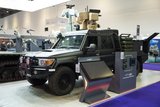NATO orders two Lanza radars
The NATO Communications and Information Agency (NCI Agency) has ordered two Lanza LTR-25 3D long-range deployable air defence radars from Indra, the company announced on 10 July.
The contract, valued at around $24.52 million, will run for 38 months. It includes an option for a third radar and other equipment that, if actioned, could bring the contract value up to $40.13 million.
The radars will be used by the NATO Air Command and Control System (ACCS), which is part of the organisation's Integrated Air and Missile Defence System.
The Lanza radars will supplement current static installations in the ACCS. They will be used to strengthen surveillance in special interest areas and provide a greater capability for international missions.
Each Lanza LTR-25 radar has a primary radar integrated with a secondary radar, a power generation and operation shelter. It can be transported in two trucks or a C-130 type aircraft and deployed in non-prepared sites.
The radar is the fifth generation of the Lanza L-band radar range and includes direct radio frequency sampling, digital beam-forming, anti-clutter, signal processing, ballistic missile detection and mono-pulse capabilities.
Related Equipment in Defence Insight
More from Digital Battlespace
-
![Babcock nears first customer for Nomad AI translation tool]()
Babcock nears first customer for Nomad AI translation tool
Nomad can provide militaries with real-time intelligence, saving critical time on the battlefield.
-
![AUSA 2025: Israel’s Asio Technologies to supply hundreds of improved Taurus tactical systems]()
AUSA 2025: Israel’s Asio Technologies to supply hundreds of improved Taurus tactical systems
Taurus operates alongside the Israel Defense Forces’ Orion system which supports mission management across tens of thousands of manoeuvring forces, from squad leaders to battalion commanders.
-
![AUSA 2025: Kopin pushes micro-LED plans as China moves faster]()
AUSA 2025: Kopin pushes micro-LED plans as China moves faster
The plan for the new displays follows fresh investment in Kopin’s European facilities by Theon and an order for head-up displays in fielded aircraft, with funding from the US Department of Defense.
-
![AUSA 2025: Persistent Systems to complete its largest order by year’s end]()
AUSA 2025: Persistent Systems to complete its largest order by year’s end
Persistent Systems received its largest ever single order for its MPU5 devices and other systems earlier this month and has already delivered the 50 units to the US Army’s 4th Infantry Division.
-
![Aselsan brings in dozens of companies and systems under the Steel Dome umbrella]()
Aselsan brings in dozens of companies and systems under the Steel Dome umbrella
Turkey has joined the family of countries attempting to establish a multilayered air defence system with government approval in August 2024 for the effort landed by Aselsan. Dubbed Steel Dome, the programme joins Israel’s Iron Dome, the US Golden Dome, India’s Mission Sudarshan Chakra and South Korea’s low-altitude missile defence system.
-
![DSEI 2025: MARSS unveils new agnostic multidomain C4 system]()
DSEI 2025: MARSS unveils new agnostic multidomain C4 system
MARSS’ NiDAR system has been deployed using sensors from static platforms to provide detection and protection for static sights, such as critical infrastructure, ports and military bases.




























